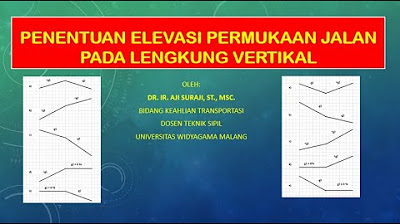Superelevation - Purpose - Design & How To Calculate It?
Summary
TLDRThis script explains the concept of super elevation in road and railway design, crucial for maintaining vehicle stability on curves. It details the formula for calculating super elevation, emphasizing its role in reducing centrifugal force's impact and enhancing safety. The script outlines the design procedure, including determining necessary super elevation for a given speed and curve radius, and discusses its advantages like increased traffic volume and reduced road maintenance costs.
Takeaways
- 🛣️ The highway's super elevation is crucial for economic growth by ensuring safe transportation on curved paths.
- 🔄 Super elevation is the transverse slope provided in curved roads and railways to counteract centrifugal force.
- 🧮 The formula for super elevation is ( e + f = v^2 / (g * r) ), where e is the rate of superelevation, f is the coefficient of lateral friction, v is the vehicle's speed, g is the acceleration due to gravity, and r is the radius of the curve.
- 🚗 Super elevation reduces the reliance on friction between tires and road, allowing vehicles to maintain speed on curves.
- 🔄 The purpose of super elevation includes counteracting centrifugal force, preventing vehicle overturning, ensuring traffic safety, and reducing road surface damage.
- 🚀 Advantages of super elevation include allowing high-speed travel on curves, even load distribution, preventing collisions, and facilitating road drainage.
- 🛠️ The design procedure involves calculating super elevation for 75% of the design speed, checking against limits, and adjusting for friction.
- ⚖️ If calculated super elevation exceeds 7%, the limit is set to 7% to ensure safety.
- 🚦 In cases where friction exceeds the safe limit, speed restrictions may be necessary to maintain road safety.
- 🔢 An example calculation for a road with a 250-meter radius and 80 km/h speed limit results in a super elevation of 0.051 meters per meter of carriageway.
- 📏 The calculated super elevation must be within the allowable limit, which is 1/10 times the road width in this case.
Q & A
What is the significance of super elevation in highway design?
-Super elevation is crucial for highway design as it enhances safety by reducing the centrifugal force's effect on vehicles navigating curved paths, allowing them to travel at higher speeds without the risk of skidding or overturning.
How is super elevation defined in the context of transportation?
-Super elevation refers to the transverse slope along the width of the road, which is achieved by raising the outer edge higher than the inner edge throughout the length of a horizontal curve, especially in road and railway transport.
What is the formula for calculating super elevation?
-The formula for super elevation is e + f = v^2 / (g * r), where e is the rate of superelevation, f is the coefficient of lateral friction, v is the design speed of the vehicle in meters per second, g is the acceleration due to gravity (9.8 m/s^2), and r is the radius of the horizontal curve in meters.
Why is it important to provide super elevation on curved roads?
-Super elevation is important to counteract the centrifugal force acting on vehicles, help fast-moving vehicles negotiate curved paths safely, ensure safety for high-speed traffic, and prevent road surface damage due to improper load distribution.
What are the advantages of implementing super elevation?
-Advantages include allowing high-speed travel on curved paths, even distribution of load on wheels for reduced wear, prevention of vehicle collisions on curved roads, and facilitating drainage towards the inner side of the road, eliminating the need for side drains.
What is the design procedure for super elevation?
-The design procedure involves calculating the necessary super elevation for 75% of the design speed assuming no lateral friction, checking if the calculated value is within the allowable limit, and if not, calculating the restricted speed or realignment of the curve for maintaining design speed without restrictions.
What is the maximum recommended super elevation percentage?
-The maximum recommended super elevation percentage is 7% or 0.07, beyond which the super elevation should not exceed to ensure safety and comfort for drivers.
How does the coefficient of friction affect the super elevation calculation?
-The coefficient of friction is used in the super elevation formula to determine the lateral force available to counteract centrifugal force. If the calculated friction coefficient is less than 0.15, the super elevation is considered safe for the design speed.
What is the purpose of calculating a restricted speed in super elevation design?
-The purpose of calculating a restricted speed is to ensure safety when the calculated friction coefficient exceeds 0.15, indicating that the design speed might be too high for the given super elevation, and a lower speed should be imposed.
Can you provide an example calculation of super elevation based on the script?
-For a road 7 meters wide on a curve with a 250-meter radius and a permissible speed of 80 km/h, the super elevation calculation would be (e + 0.15) = (80 * 1000 / 3600)^2 / (127 * 250), resulting in e = 0.051 meters per meter of carriageway, which is within the allowable limit of 0.70 meters.
Outlines

Dieser Bereich ist nur für Premium-Benutzer verfügbar. Bitte führen Sie ein Upgrade durch, um auf diesen Abschnitt zuzugreifen.
Upgrade durchführenMindmap

Dieser Bereich ist nur für Premium-Benutzer verfügbar. Bitte führen Sie ein Upgrade durch, um auf diesen Abschnitt zuzugreifen.
Upgrade durchführenKeywords

Dieser Bereich ist nur für Premium-Benutzer verfügbar. Bitte führen Sie ein Upgrade durch, um auf diesen Abschnitt zuzugreifen.
Upgrade durchführenHighlights

Dieser Bereich ist nur für Premium-Benutzer verfügbar. Bitte führen Sie ein Upgrade durch, um auf diesen Abschnitt zuzugreifen.
Upgrade durchführenTranscripts

Dieser Bereich ist nur für Premium-Benutzer verfügbar. Bitte führen Sie ein Upgrade durch, um auf diesen Abschnitt zuzugreifen.
Upgrade durchführenWeitere ähnliche Videos ansehen
5.0 / 5 (0 votes)






